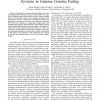Free Online Productivity Tools
i2Speak
i2Symbol
i2OCR
iTex2Img
iWeb2Print
iWeb2Shot
i2Type
iPdf2Split
iPdf2Merge
i2Bopomofo
i2Arabic
i2Style
i2Image
i2PDF
iLatex2Rtf
Sci2ools
89
Voted
GLOBECOM
2008
IEEE
2008
IEEE
Performance Analysis of Free-Space Optical Systems in Gamma-Gamma Fading
— Atmospheric turbulence induced fading is one of the main impairments affecting free–space optics (FSO). In recent years, Gamma–Gamma fading has become the dominant fading model for FSO links because of its excellent agreement with measurement data for a wide range of turbulence conditions. In this paper, we express the bit error rate of intensity modulated FSO with direct detection in single–input single–output and multiple–input multiple–output Gamma–Gamma fading channels as generalized infinite power series with respect to the signal–to– noise ratio. For fast numerical evaluation these power series are truncated to a finite number of terms and an upper bound for the associated approximation error is provided. Another contribution of this paper is the extension of the well–known RF concepts of diversity and combining gain to FSO and Gamma–Gamma fading.
Dominant Fading Model | Gamma–Gamma Fading | GLOBECOM 2008 | Intensity Modulated Fso | Telecommunications |
| Added | 29 May 2010 |
| Updated | 29 May 2010 |
| Type | Conference |
| Year | 2008 |
| Where | GLOBECOM |
| Authors | Ehsan Bayaki, Robert Schober, Ranjan K. Mallik |
Comments (0)

